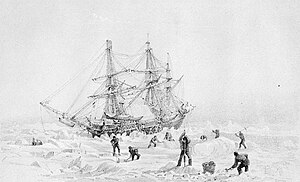HMS Terror

HMS Terror in the Arctic
|
|
| History | |
|---|---|
|
|
|
| Name: | Terror |
| Ordered: | 30 March 1812 |
| Builder: | Robert Davy, Topsham, Devon |
| Laid down: | September 1812 |
| Launched: | 19 June 1813 |
| Completed: | By 31 July 1813 |
| Fate: | Abandoned in Terror Bay, Canada, 22 April 1848 |
| General characteristics | |
| Class and type: | Vesuvius-class bomb vessel |
| Tons burthen: | 325 (bm) |
| Length: | 102 ft (31.09 m) |
| Beam: | 27 ft (8.23 m) |
| Installed power: | 30 hp (22 kW) nhp |
| Propulsion: | |
| Complement: | 67 |
| Armament: |
|
| Official name | Erebus and Terror National Historic Site of Canada |
| Designated | 1992 |
HMS Terror was a bomb vessel constructed for the Royal Navy in 1813. She participated in several battles of the War of 1812, including the bombardment of Fort McHenry. Later converted into a polar exploration ship, she participated in George Back's Arctic expedition of 1836–1837, the Ross expedition of 1839 to 1843, and Sir John Franklin's ill-fated attempt to force the Northwest Passage in 1845, during which she was lost with all hands along with HMS Erebus.
On 12 September 2016, the Arctic Research Foundation announced that the wreck of Terror had been found in Nunavut's Terror Bay, off the southwest coast of King William Island. The wreck was discovered 92 km (57 mi) south of the location where the ship was reported abandoned, and some 50 km (31 mi) from the wreck of HMS Erebus, discovered in 2014.
HMS Terror was a Vesuvius-class bomb ship built over two years at the Davy shipyard in Topsham, Devon, for the Royal Navy. Her deck was 31 m (102 ft) long, and the ship measured 325 tons burthen. The vessel was armed with two mortars and ten cannons, and was launched in June 1813.
Terror saw service in the War of 1812 against the United States. Under the command of John Sheridan, she took part in the bombardment of Stonington, Connecticut, on 9–12 August 1814. She also fought in the Battle of Baltimore in September 1814 and participated in the bombardment of Fort McHenry; the latter attack inspired Francis Scott Key to write the poem that eventually became known as "The Star-Spangled Banner". In January 1815, still under Sheridan's command, Terror was involved in the Battle of Fort Peter and the attack on St. Marys, Georgia.
...
Wikipedia
